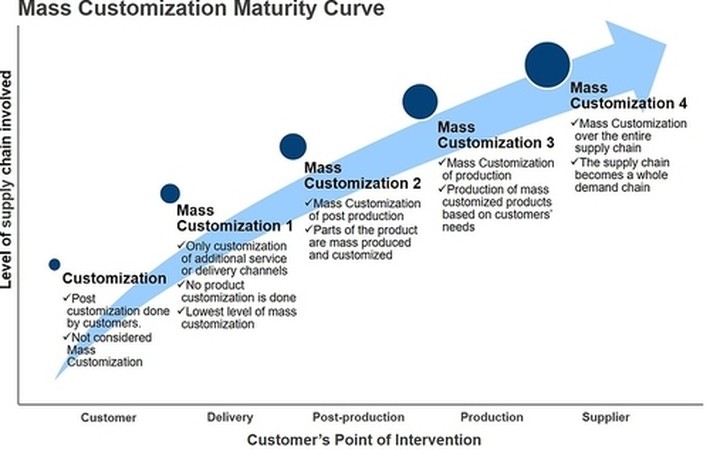
Published on 06/23/2016 | IoT Index
Mass customization, as Joseph Pine defined in his book Mass Customization: The New Frontier in Business Competition is
"a company’s capability to develop, produce, market, and deliver goods that feature enough variety and customization that nearly everyone can get exactly what he or she wants. Mass customization is when something is efficiently customized on demand—not in advance—and it doesn’t cost a heck of a lot more to make than it would if you were making it for everyone at once."
Though mass customization has grown since the middle 1990s, thanks in large part to the Internet, an era of mass customized commercial and engineered products has yet to fully arrive. Significant impediments to widespread adoption still remain.
By looking at the Mass Customization Maturity Curve, companies or industries can quickly allocate their own mass customization maturity level and also determine whether their customers are ready to contribute to be a part of this mass customized production supply chain.
There are 5 levels of mass customized of production:
No Mass Customization: customization is only done by customers.
Mass Customization Level 1: No product mass customization. Mass customization is done in additional services or delivery channel.
Mass Customization Level 2: Post-production Mass Customization. Parts of the product are mass produced and customized post-production adjusts the product to customers needs.
Mass Customization Level 3: Mass Customization of Production. Production of mass customized products based on customers' needs. Unique products are produced to satisfy unique needs.
Mass Customization Level 4: The entire supply chain network is transparent to the customers. Customized CAD, CAE, CAM are used by customers to design their products. Mass customization over the entire supply chain requires binding companies into network in order to satisfy the needs of the customers.
Mass customization affects not only the production systems, but also almost every part of the company. Information systems for the mass customization have to be able to handle the huge number of possible product variety. Move to the digital economy is the first step to the mass customization. Information systems allow the customers communicate their needs and create their own products. They provide as well the communication over the entire supply chain. When the point of customer intervention in the supply chain moves all the way to the left, the supply chain becomes a full demand chain.